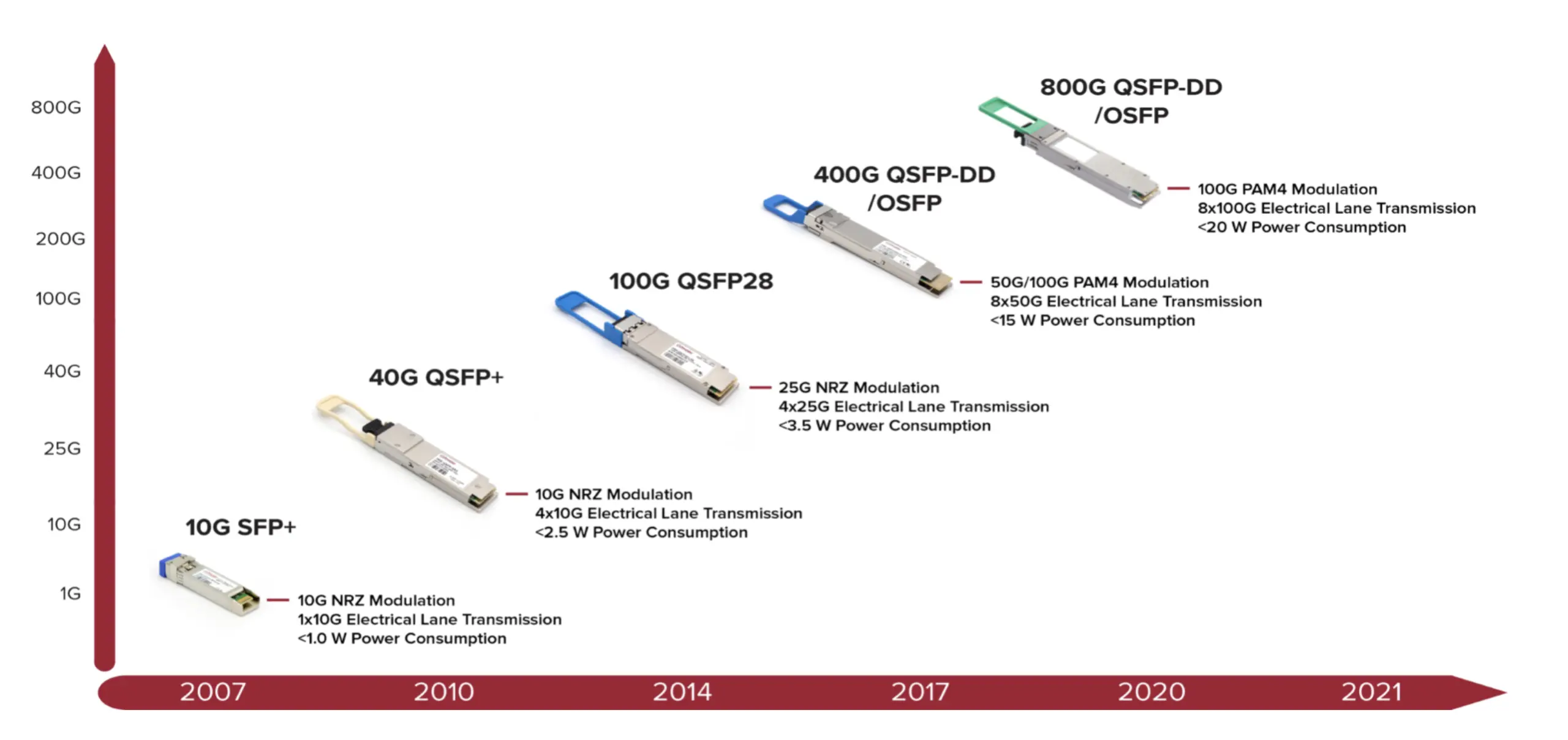
How PAM4 Enabled the Leap to 400G

In this blog, we take a higher-level look at PAM4, the modulation scheme that makes short distance 400G networking possible, and discuss how this technology has enabled big leaps in optical networking as we know it.
Introduction
Insatiable – that’s a word that so aptly describes the ever-growing bandwidth demands of global end-users. Whereas only recently we started to move past 100G and embrace the potential of 400G, it’s already clear to many in the optical networking space that soon, 800G will become a necessity. As the wider telecommunications landscape looks forward to implementing new innovations in virtual reality, AI and 5G, there will be a corresponding surge in demand for the speed and capacity that 400G/800G offers – especially for short range use cases like data center interconnectivity. The graph below shows an overview of the most common pluggables over the past couple decades. The physical form factors are shown as well as the optical data rate output and some of the technological advances. A key new modulation scheme, PAM4, was introduced around 2017 and enabled the big jump from 100G to 400G.
When it comes to enabling 400G and higher Ethernet speeds, a four-level pulse amplitude modulation or PAM4 multilevel signaling is needed as opposed to the non-return-to-zero (NRZ) modulation preferred for 100G applications. So what is PAM4 modulation and how has it transformed optical networking?
What is PAM4-Enabled 400G?
Network engineers have long utilized non-return to zero (NRZ) modulation for 1G, 10G and 25G, using host side forward error correction (FEC) to enable longer distance transmissions. To get from 40G to 100G, the industry simply turned to parallelization of the 10G/25G NRZ modulations, also utilizing host side FEC for the longer distances. When it comes to achieving speeds of 400G/800G and faster, these standard technologies are just not cost effective anymore. As a result, optical networking engineers have moved to PAM4 modulation to bring these ultra-high-bandwidth network architectures to fruition, therefore cost effectiveness is one of the drivers of PAM4-enabled 400G and higher.
Fig 1a) NRZ Modulation
Fig 1b) PAM4 Modulation
PAM4 is a modulation scheme that combines two bits into a single symbol with four amplitude levels as shown in Fig. 1b. This effectively doubles a network’s data rate, enabling 400G/800G short-haul transmission. As a result, it is an effective answer to network operators’ needs for a cost-effective solution that NRZ simply cannot provide.
Deployment Timelines: Upgrading Networks for 400G and looking ahead to 800G
Although PAM4 enables optical network operators to pursue short haul 400G transmission, it does create a penalty on signal to noise ratio (SNR). This is why the distance for transmission becomes shorter, in the realm of distances up to 10km. At the same time, there is also a much greater need for FEC to mitigate the loss of signal integrity. PAM4 may not necessarily mean a need for more equipment even though transmission distances are shorter. However, it does mandate a need for more signal processing, more error correction, and higher performing components within a network’s architecture.
Optical transceivers capable of 400G also tend to require more power than those for 100G and smaller. We are also seeing a new generation of network switches that PAM4-enabled 400G transceivers can plug into. Network operator interest in 400G transmission continues to be high, but it will likely be some time before we see this technology deployed on a widespread basis.
At the OFC ‘23 conference in San Diego, there was much discussion of the latest advancements in coherent technologies, however it was acknowledged that direct-detect PAM4 optics may still have an edge in the data center due to lower cost and lower power. Scott Wilkinson of Cignal AI reports “The performance of current generation 400GbE PAM4-based optics and the initial 800GbE PAM4 optics will keep coherent optics out of the datacenter until at least the advent to 1.6TbE optics – and perhaps even further.”
For some years now, AT&T has been investing in upgrading its network to 400G to support the unprecedented waves of traffic that 5G promises to produce. According to Fierce Telecom, AT&T’s “400G-based IP backbone currently carries 594 petabytes of domestic traffic each day and noted plans are in place to ensure its core architecture can scale as bandwidth demand rises.” From a 5G perspective, we’ve seen that short-haul 400G data center interconnectivity is becoming especially salient as carriers/service providers look to leverage increased network virtualization. Even though 400G is still new to many, most now recognize it is necessary to meet the bandwidth-hungry needs of network subscribers around the world.
Precision OT’s Role
Precision OT is a systems engineering and integration company focused on optical transceivers and related active/passive optical components. The Precision OT team carries a complete line of 400G-capable optical transceivers to meet the growing demand for high quality next-gen optics. PAM4 modulation goes hand in hand with these new offerings and 800G optics will be coming soon. Contact us today to ask us more about what we can do to support your 400G needs.









